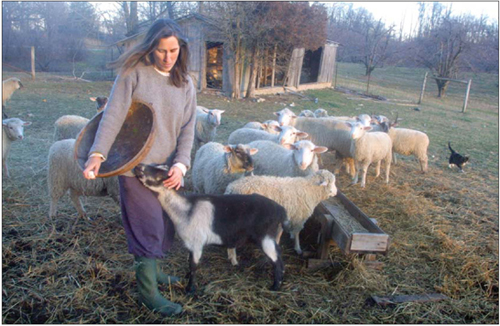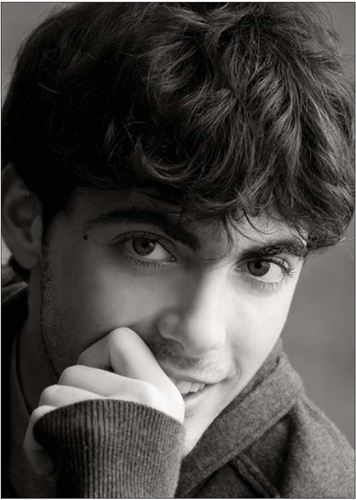CHAPTER 7:
NETWORKING WITH OTHER PHOTOGRAPHERS
There are many reasons to join a community of photographers: to network, shoot the breeze, commiserate, compare notes, share technique, battle creative slumps and to establish and maintain industry standards, to name just a few.
REFERRALS
One of the biggest ways my colleagues and I help each other is by trading referrals. This is especially important now that many of us have become very specialized. For my portraits, I shoot only black-and-white film and offer only high-end archival pieces. I strictly do black- and-white, sepia or hand-painted portraits of kids, their families and their pets. No corporate head shots. No events.

A travel image by Jim Miotke.
Frequently I get calls from clients wanting a service or product outside of my specialty. Requests for weddings, model composites or product shots are common. In the past, I tried to accommodate these requests myself but was often less than happy with the results, preferring ultimately to work only within my limited specialty. So it's a great boon for me to know professionals who I'm proud to refer my clients to. And it's always nice to get a referral from one of my colleagues, of course.
MENTORS
Almost every successful photographer I've ever known has credited their success in part to the generosity of a more established shooter who helped them learn the ropes. There's no law that says an old dog has to teach a new dog his tricks. And there can be some risk in volved if the protégé turns into an upstart who runs away with part of the mentor's market. So why do it?

An editorial image by Stormi Greener.
“It's for the joy of it,” says Jim Miotke.
“It's a natural part of the life cycle,” says Jennifer Wu. “You're born, you learn, you teach, you die.”
PROFESSIONAL TRADES
I've traded shoots and offered and received shoots and prints at a discount from my colleagues. I received a beautiful art print from a nature photographer in exchange for shooting his family. I've done portraits for a wedding photographer in return for shooting my wedding.
EQUIPMENT SAVVY
Whenever I've needed a new piece of equipment, especially when it comes to new technology with which I'm unfamiliar, I ask for the inside scoop from my photographer friends. A commercial shooter taught me everything I needed to know about digital capture, researched the systems from me and helped me choose which one to buy. A fashion shooter taught me how to use strobes, an architectural shooter taught me about hot lights, and a photojournalist taught me that it's okay (and sometimes even desirable) to use mixed light sources.
In turn, I've helped some medium-format junkies break their addictions to fine grain and tripods; I've taught a commercial shooter how to get two-year-olds to stand in one spot for a 250th of a second; and I've shared my somewhat paltry knowledge of digital capture with a fellow film lover whose digital knowledge was even more paltry than mine. What goes around really does come around.
INDUSTRY STANDARDS
American Society of Media Photographers (ASMP) offers a book detailing industry standards for billing, determining usage fees and other practices. The book is invaluable. But ASMP, the society, didn't institute these standards. Individual photographers, the guys in the trenches, created them. Industry standards continue to evolve as technology, the economy and our markets change. By networking with fellow shooters you can help create the standards.
CLASSES AND SEMINARS
Classes and seminars are good ways to meet other photographers. In addition to picking up some great ideas over the years, I've also met and remained in contact with several photographers this way.
CONSULTING
If you're going into a new specialty, making the transition to digital or hitting a marketing slump, you may need more than the casual assist that a colleague or a mentor can offer. You may need a hired gun. I've both worked as a consultant for other photographers and hired other photographers to consult for me. It's a way to significantly shorten up your learning curve when you need knowledge and you need it fast.
INTERNET CLUBS AND DISCUSSION GROUPS
Joining an Internet discussion group allows you to network with your brethren from all over the globe. You can put a technical, creative or business question out there and receive twenty different (and often excellent) responses from twenty different individuals in a very short time.
TALKING SHOP
Networking with colleagues allows you to check the pulse of the business. You can find out if others are slow or busy and whether they're sensing any new trends or having success with new equipment and technology.
You can also commiserate with those who understand your experiences. I try not to be negative, but sometimes I just need to do a little venting and having an ear from a person who knows what you're talking about is a wonderful thing.
You can also use the grapevine to find out about studio management software, good vendors and labs, and studio sales where you can pick up used equipment for pennies on the dollar.
You can compare business practices, get the name of a good lawyer or accountant … you get the idea.
Some shooters are afraid to network for fear of having their clients, ideas or business practices stolen. And yes, it does happen. But in my experience, the gains far outweigh the losses when you share your time and expertise with your fellow photographers.

A senior portrait by Vik Orenstein.
CROSS DISCIPLINE TRAINING
I'm a portrait photographer but most of what I know about lighting I learned from architectural photographers, and my philosophy of photographing kids comes from a style prevalent among fashion photographers in the early 1980s. One way to develop a distinct visual style is to do things differently from the way your competitors are doing them, and you don't need to roam far afield or be intentionally clever or contrived to create a new look. All you have to do is pick and choose from established traditions in other photographic specialties. Networking makes finding new perspectives easy.

A portrait by Vik Orenstein.
HOW TO START
If you've never networked before, it may seem a little daunting. Many of us dislike asking others for their time or knowledge.
• BE SPECIFIC. I'm much more likely to take time out of my schedule to talk to a peer if she's specific about what kind of information she's looking for. For instance, I'm unlikely to go out of my way to meet with someone who just calls up and says, “I'd like to pick your brain about photography.”But if someone calls and says, “I'm at the stage in my business where I'm forced to decide whether to scale back or expand my studio space and take on more employees. Since you have experience with this, I was hoping we could meet and discuss the pros and cons.”
• HAVE SOMETHING TO TRADE. If you're looking for marketing ideas, for instance, you might say, “Hey, I have some promotions I've been using with some success, and I was wondering if we might get together and bat some marketing ideas back and forth.”
• TELL THEM WHY YOU CHOSE THEM. You're more likely to get results if you tell your colleagues why you chose them to speak with rather than appearing to have picked them out of the phone book. Say, “I've seen your work and I love your use of color, and that's why I'd like to ask you about your creative technique.” Or, “I really admire what you've done with your business, and I'd like to hear your ideas on how to sell.”
• FOOD IS LOVE. It's human nature — we feel more comfortable and relaxed when we break bread with someone than in any other setting. So suggest lunch, or even coffee. And pick up the tab.
PROFESSIONAL ASSOCIATIONS
As I've mentioned in previous chapters, I highly recommend you join your local chapter of ASMP or Professional Photographers of America or one of any number of other great organizations. You're looking for colleagues to network with. This is a way to find a whole room full of those who are primed and ready to talk shop. And don't just join — go to the meetings!
YOUR NEIGHBORS
In the first years of my career as a photographer I was lucky enough to have my studio in a warehouse building that was also home to tens of other photographers in different disciplines. When I was just starting out, I rented studio space on an asneeded basis from a commercial photographer, and he taught me all about medium-format equipment. All I had to do was go across the hall when I needed to borrow a sync cord (the photographer's equivalent of a cup of sugar). And when a client pulled a fast one on me and brought a reflective product to a shoot that was only supposed to involve kids, I excused myself, went up two flights of stairs and got a quick lighting lesson that allowed me to do the shot unfazed. In turn, I helped a fashion shooter keep an uncooperative four-year-old girl on a white seamless background and get her to pose and laugh. (I stuck a raisin to the bottom of her foot and told her to say “diaper head.”) Look around — there are no doubt photographers nearby who would be happy to network with you.
